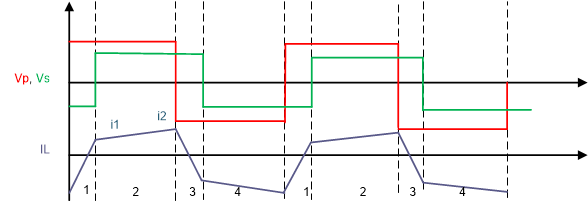TIDUES0E June 2019 – April 2024 TMS320F28P550SJ , TMS320F28P559SJ-Q1
- 1
- Description
- Resources
- Features
- Applications
- 6
- 1System Description
- 2System Overview
- 3Circuit Description
- 4Hardware, Software, Testing Requirements, and Test Results
- 5Design Files
- 6Related Documentation
- 7Terminology
- 8About the Author
- 9Revision History
2.3.4.1 Leakage Inductor
The primary specifications for designing a power converter system are input voltage V1, output voltage V2, and the maximum required power transfer. The power transfer relation of the dual-active bridge is given by Equation 6. The best value for N is V1,nom/V2,nom, which is 1.6 for this designs specifications.
where
- V1 is the primary-side voltage
- V2 is the secondary-side voltage
- N is the primary to secondary turns ratio
- φ is the phase shift in radians
- Fs is the switching frequency
- L is the leakage or coupling inductance
Equation 6 shows that the power transfer can be controlled with the phase shift φ, where the maximum power transfer occurs for φ = π / 2.
With V1 and V2 fixed, there are two variables left to design for the required output power. These are the switching frequency Fs and the leakage inductance L. With FSset to 100 kHz, L is selected as 35 µH. This allows a theoretical maximum power transfer of 22.85 kW. This leaves some headroom above the target power of 10 kW, which is required for lower output voltages.
The selection of the inductor defines the maximum current stress in the switch node of the converter.
Figure 2-15 shows the inductor current waveform. The currents at points i1 and i2 can be derived from this waveform.
where
- d is the voltage transfer ratio of the converter given in Equation 9
- Ibase is the nominal base current of the converter given in Equation 10
 Figure 2-15 Inductor Current
Waveform
Figure 2-15 Inductor Current
Waveform